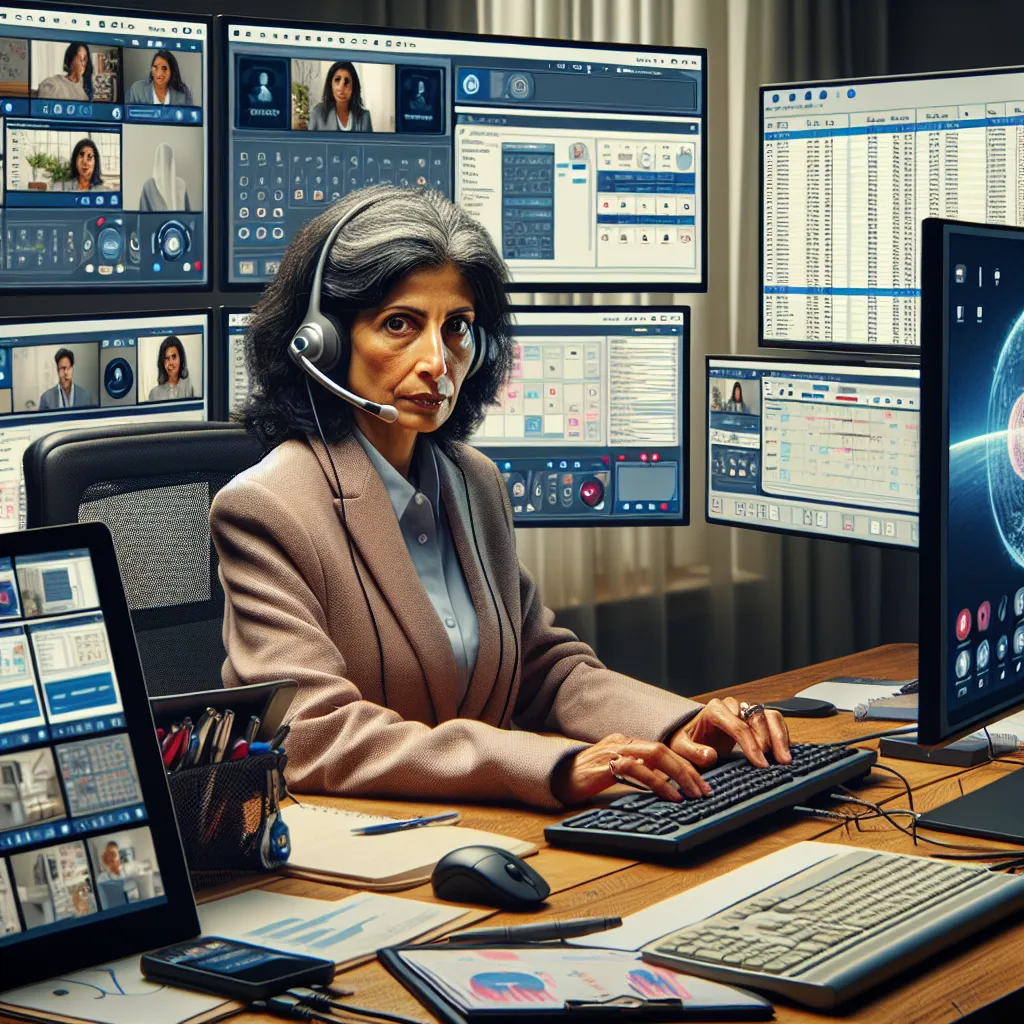Virtual team-building activities have become increasingly common in today’s digital workplace. As such, this topic is gaining relevance in IELTS Speaking tests. This article will guide you through answering questions related to virtual team-building experiences, helping you achieve a high band score in your IELTS Speaking exam.
Nội dung bài viết
Understanding the Topic
Before we dive into the specifics, let’s analyze the key elements of the topic “Describe a time when you participated in a virtual team-building activity”:
- Virtual: This indicates an online or digital environment
- Team-building: Activities designed to improve teamwork and collaboration
- Activity: A specific event or exercise
- Participated: Your personal involvement and experience
This topic combines elements of technology, workplace dynamics, and personal experiences, making it a rich subject for discussion in an IELTS Speaking test.
 Virtual Team Building Activity
Virtual Team Building Activity
Part 1: Introduction and Interview
In Part 1, the examiner may ask general questions about team-building activities and virtual communication. Here are some possible questions and sample answers:
- Do you enjoy team-building activities?
Band 6-7 Answer:
“Yes, I quite enjoy team-building activities. They’re a good way to get to know my colleagues better and improve our working relationships.”
Band 8-9 Answer:
“Absolutely! I find team-building activities incredibly valuable. They not only foster better relationships among colleagues but also enhance communication and boost morale in the workplace. I particularly appreciate how these activities can reveal hidden talents and strengths in my coworkers that might not be apparent in our day-to-day interactions.”
- How often do you participate in virtual meetings?
Band 6-7 Answer:
“I participate in virtual meetings quite regularly, probably a few times a week. They’ve become an essential part of our work routine, especially since the pandemic.”
Band 8-9 Answer:
“Virtual meetings have become an integral part of my professional life. I engage in them on a daily basis, ranging from quick check-ins with colleagues to more elaborate project discussions and team collaborations. The frequency and importance of these virtual interactions have skyrocketed since the onset of remote work trends, making them a cornerstone of modern workplace communication.”
Part 2: Long Turn
Here’s a sample cue card for this topic:
Describe a time when you participated in a virtual team-building activity.
You should say:
- What the activity was
- When and where it took place
- Who participated in it
- And explain how you felt about this virtual team-building experience
Band 6-7 Answer:
“I’d like to talk about a virtual escape room activity I participated in last year. It was organized by my company as a team-building exercise during the pandemic. The activity took place online, and we used video conferencing software to communicate.
The virtual escape room was set in a haunted mansion, and we had to solve puzzles and riddles to ‘escape’ within an hour. There were about 20 of us participating, divided into teams of five. We had to work together to find clues, decode messages, and unlock virtual doors.
I found the experience quite enjoyable. It was a nice break from our usual work routine, and it was interesting to see how we could collaborate virtually. The activity helped us improve our communication skills and learn to work together under pressure.
Overall, I felt positive about the experience. It was a fun way to connect with colleagues despite working remotely, and I think it helped strengthen our team bonds.”
Band 8-9 Answer:
“I’d be delighted to share my experience of a particularly memorable virtual team-building activity I participated in last year. Our company orchestrated a sophisticated virtual escape room challenge, which took place in the midst of the pandemic when remote work had become the norm.
The activity was ingeniously designed as an immersive experience set in a mysterious, haunted mansion. We were tasked with deciphering complex puzzles and unraveling intricate riddles to successfully ‘escape’ within a stringent one-hour timeframe. The event was hosted on a cutting-edge video conferencing platform, which facilitated seamless interaction among participants.
Our entire department, comprising approximately 20 individuals, was involved in this endeavor. We were strategically divided into teams of five, fostering a sense of camaraderie and healthy competition. The challenge required us to synergize our diverse skill sets, from analytical thinking to creative problem-solving, in order to uncover clues, decode cryptic messages, and unlock virtual doors.
I found the experience to be profoundly engaging and enlightening. It served as a welcome respite from our daily work routines and shed light on the untapped potential of virtual collaboration. The activity significantly enhanced our communication skills and tested our ability to work cohesively under pressure in a digital environment.
In retrospect, I feel overwhelmingly positive about this virtual team-building experience. It was an innovative and effective approach to fostering connections among colleagues despite the physical distances imposed by remote work. Moreover, I believe it substantially strengthened our team dynamics and cultivated a deeper sense of unity within our department. The creative use of technology to simulate a shared experience was truly impressive and forward-thinking.”
Follow-up Questions
- How did this virtual team-building activity differ from in-person activities you’ve experienced?
Band 6-7 Answer:
“The main difference was the lack of physical presence. We couldn’t see body language as clearly, which made communication a bit challenging. However, it was interesting to see how we adapted to the virtual environment.”
Band 8-9 Answer:
“The virtual nature of this activity presented unique challenges and opportunities that set it apart from traditional in-person team-building exercises. The absence of physical proximity necessitated a heightened focus on verbal communication and active listening. While we lost some nuances of body language, we gained proficiency in utilizing digital tools and navigating virtual spaces collaboratively. This experience underscored the importance of adaptability in our increasingly digital work landscape and showcased our team’s resilience in the face of new challenges.”
- Do you think virtual team-building activities are as effective as in-person ones?
Band 6-7 Answer:
“I think both have their strengths. Virtual activities are more convenient and inclusive for remote teams, but in-person activities allow for more natural interactions. Overall, I believe virtual activities can be quite effective if well-planned.”
Band 8-9 Answer:
“The efficacy of virtual versus in-person team-building activities is a nuanced topic. While in-person activities benefit from the richness of face-to-face interaction and shared physical experiences, virtual activities offer unparalleled accessibility and inclusivity, especially for geographically dispersed teams. Virtual activities, when thoughtfully designed and executed, can be remarkably effective in fostering collaboration and building team cohesion. They also cultivate essential skills for the modern workplace, such as digital literacy and remote collaboration. Ultimately, the most effective approach may be a hybrid model that leverages the strengths of both virtual and in-person activities to create a comprehensive team-building strategy.”
Part 3: Two-way Discussion
In this part, the examiner will ask more abstract questions related to the topic. Here are some potential questions and sample answers:
- How do you think technology has changed the way teams collaborate?
Band 6-7 Answer:
“Technology has made collaboration much easier and more flexible. Teams can now work together from different locations and time zones. Tools like video conferencing and project management software have made sharing ideas and information much simpler.”
Band 8-9 Answer:
“Technology has revolutionized team collaboration in profound ways. It has transcended geographical boundaries, enabling seamless cooperation among team members across the globe. Advanced communication platforms and cloud-based project management tools have facilitated real-time information sharing and enhanced productivity. Moreover, technology has democratized the workplace, giving voice to introverted team members who might be hesitant to speak up in traditional settings. However, it’s crucial to acknowledge that this digital transformation also presents challenges, such as maintaining work-life balance and combating digital fatigue. The key lies in harnessing technology’s potential while being mindful of its limitations and potential drawbacks.”
- What skills do you think are essential for effective virtual teamwork?
Band 6-7 Answer:
“I think good communication skills are crucial for virtual teamwork. Being able to express yourself clearly in writing and speaking is important. Also, time management and self-discipline are necessary since you’re often working independently.”
Band 8-9 Answer:
“Effective virtual teamwork requires a diverse skill set that goes beyond traditional collaboration competencies. Exceptional communication skills are paramount, encompassing not only verbal and written proficiency but also the ability to convey nuanced ideas through digital mediums. Digital literacy is crucial, as team members must be adept at navigating various online platforms and tools. Emotional intelligence plays a vital role in fostering empathy and maintaining team cohesion in a virtual environment. Adaptability and resilience are essential for navigating the challenges of remote work. Additionally, self-motivation and time management skills are critical for maintaining productivity without direct supervision. Lastly, cultural competence is increasingly important as virtual teams often span different countries and cultures.”
Key Vocabulary and Phrases for High Scores
To achieve a high band score, incorporate sophisticated vocabulary and phrases into your responses. Here are some examples:
-
Orchestrate (verb) /ˈɔːkɪstreɪt/ – to arrange or plan something carefully
Example: “The HR department orchestrated a series of virtual team-building activities.” -
Synergize (verb) /ˈsɪnədʒaɪz/ – to combine or work together in order to produce a better result
Example: “The virtual escape room required us to synergize our diverse skills.” -
Cultivate (verb) /ˈkʌltɪveɪt/ – to try to develop or improve something
Example: “These activities help cultivate a sense of unity among remote workers.” -
Profoundly (adverb) /prəˈfaʊndli/ – very greatly or extremely
Example: “The experience was profoundly engaging and enlightening.” -
Innovative (adjective) /ˈɪnəveɪtɪv/ – introducing new ideas; original and creative in thinking
Example: “It was an innovative approach to team building in a virtual environment.”
Tips from an IELTS Speaking Examiner
As an experienced IELTS examiner, I recommend the following to excel in your Speaking test:
- Practice regularly with a variety of topics, including current trends like virtual team-building.
- Focus on developing a wide range of vocabulary and using it naturally in your responses.
- Work on your pronunciation and fluency through consistent speaking practice.
- Learn to elaborate on your answers with relevant examples and personal experiences.
- Stay informed about current events and global issues to handle a wide range of topics confidently.
Remember, the key to success in IELTS Speaking is not just about language proficiency, but also about expressing your ideas clearly and confidently. Good luck with your preparation!


